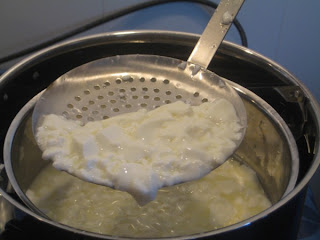This past week I took a day off to learn how to make cheese. No, I'm not thinking of switching careers, but I did think the class would be interesting. And I was right.
The course was at
Glengarry Fine Cheese, about an hour and a half southeast of Ottawa, just past a little town called Alexandria. (Lots of hilariously-named shops in Alexandria, including The Book Nook and Bite Me, a sandwich shop located next to the funeral home, which is, presumably, where one goes after you Bite It.) But I digress...
The drive was quite nice through farm country. I passed lots of corn fields.
This is what the workroom looked like. This is the cheddar station, obviously. Not pictured were the gouda and mozzarella station, and the camembert and feta station.
First task was to warm the milk (cow, whole and homogenized from a local dairy) to the appropriate temperature. Different cheeses require different temperatures, but most ranged between about 29-32C. The milk was inside a water bath to help keep the temperature regulated.
Then we added the starter, which got the whole process going, leaving us with curds that looked a bit like cottage cheese.
These curds got poured into moulds to become camembert.
Look at all that whey draining out.
And here are the mozzarella moulds draining.
Let's check on the cheddar. The milk solidified and turned jelly-like until we could cut it into cubes with a knife.
Next we continued to break down the curds with a whisk. I was in charge of this pot, which I turned into curds deemed unsatisfactory compared to the other pot. Curd making fail!
Here's the cheddar as actual curds. We pushed them through a Starfrit french fry cutter to get the shape. Once the salt is added, the curds twist up into that familiar shape. Squeaky goodness!
Break time. Lots of cheese varieties to sample.
Back to work. These are the mozzarella curds, waiting to be cut into smaller pieces, then dunked into hot water to be stretched.
Stretch that cheese! The water was so so hot. This is also how cheese strings are made.
Pressing the gouda into a mould. I learned it's pronounced gow-da, not goo-da, so now you know too.
Getting rid of the whey. This whey goes to pigs on two nearby pig farms.
Last lesson of the day: waxing blocks of gouda to protect and prevent mould growth.
All in all, a fun and informative day. We divvied up all the cheese we make among the 12 students. I brought home a bag of curd, some feta cheese (currently brining in my fridge) and some camembert, which is now "ageing" in my basement. I need to babysit it for the next six weeks, checking for mould and then turning it every two days. So basically it'll be like having a kid, right? You all should take bets now on whether I'll forget about it altogether, only to discover a mouldy, smelly mess sometime next spring.
Happy cheese eating!

















